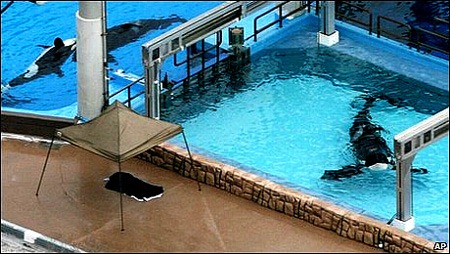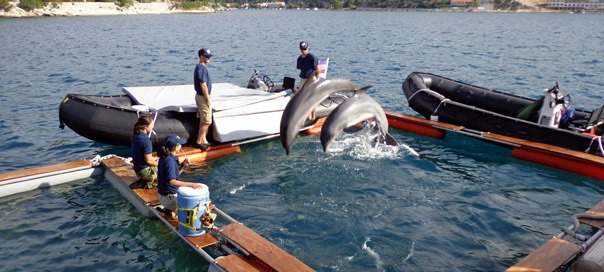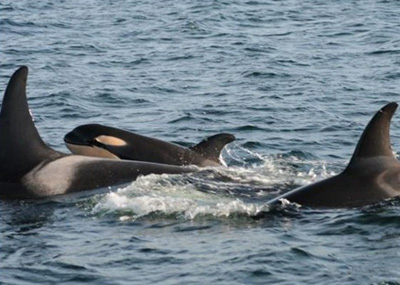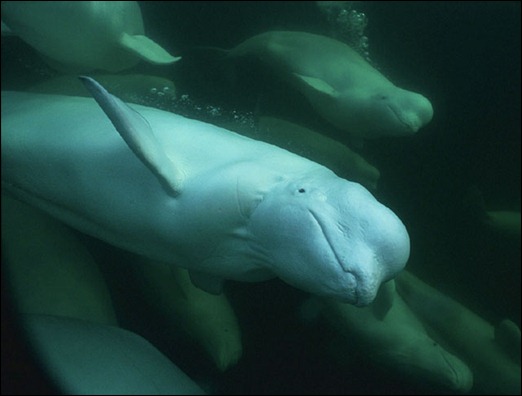Noc, Noc, Who’s There?
There’s lots of talk this week about a “talking” beluga whale who died five years ago at a U.S. Navy facility. And it’s all grist to…
 The Whale Who Took Down SeaWorld
The Whale Who Took Down SeaWorld
 How SeaWorld Is Like Scientology
How SeaWorld Is Like Scientology
 Navy Dolphins Scout for Mines in Croatia
Navy Dolphins Scout for Mines in Croatia
 Orca Dinner Party
Orca Dinner Party
There’s lots of talk this week about a “talking” beluga whale who died five years ago at a U.S. Navy facility. And it’s all grist to…
Wandering behind the scenes at a Japanese marine zoo, Chinese photographer Huang-Ju came across this scene.
“I saw the workers scrubbing this tank,” he says, “but then I suddenly realized there were dolphins lying in the drained pool. I was shocked at how the staff ignored the dolphin and didn’t seem to be in any hurry to refill the pool.”
The photo won Huan-Ju a special commendation in this year’s photo contest for the Veolia Environnement The World in Our Hands Award.
Sounds like something out of a bad James Bond movie. The Ukrainian navy is training captive dolphins to attack enemy swimmers. According to RIA Novosti: The…
Orca experts visit Puget Sound, off the coast of Seattle, and compare the life of a killer whale in the wild (the real sea world) with…
Here’s a video from Sunday’s massive demonstration at Marineland, Niagara Falls. Some of the 500 people at this peaceful but vociferous event gained access to the…
As a crowd of 500 protesters gathered outside of Marineland at Niagara Falls on Sunday afternoon, 100 of them broke from the main demonstration and charged into the zoo itself shouting “Shut it down, Shut it down!” This followed the release, earlier in the week, of two official reports about conditions at Marineland.
More of the story and how you can help wild dolphins here.
Why is Nakai, one of the orcas at SeaWorld San Diego, swimming around the tank with half his chin missing? Whatever the exact cause of his wound, one thing is for sure: things like this don’t happen to orcas in the wild. It’s just the latest in an endless series of injuries at deaths at marine circuses.
When killer whale Tilikum killed his trainer, Dawn Brancheau, two and a half years ago, David Kirby started work on a book, “Death at SeaWorld.” He…
The following extensive notes are from Naomi Rose at Humane Society International, who will be testifying at the permit hearings. A complete pdf of these notes, along with queries for the aquarium and the National Marine and Fisheries Service, which authorizes permits, can be downloaded here, along with information for obtaining complete source materials.
These are questions that can be posed to the Georgia Aquarium about their capture of 18 beluga whales for import into the United States:
All the permit application materials regarding the Georgia Aquarium’s beluga import permit application are available at the website of the federal NOAA/NMFS agency. You can submit comments there. And you can contact the the Georgia Aquarium as follows:
(Part Seven of this series.) Gaining a permit to bring dolphins and whales into captivity involves negotiating a thicket of legal, moral and public relations issues. The captivity hasn’t tried this for almost 20 years. If the Georgia Aquarium succeeds with the belugas they’ve captured in Russia, it will open the door to a flood of new imports for the marine zoos and circuses. At a public hearing, Naomi Rose of Humane Society International will be arguing the case for returning those belugas to their homes and families.
(Sixth in the series.) When she was two years old, a lonely orphan beluga began making friends with fishermen and tourists in Chedabucto Bay, Nova Scotia. But as she became habituated to humans and boats, she was injured several times by propellers. And instead of learning to be part of a beluga family, she was learning to sound like a propeller and to mimic the human children who were calling out to her.
(Fifth in our series about beluga whales in captivity.) They’re cute, charming, chatty, curious and all-round delightful. And that’s their problem – it makes them prime targets of the captivity industry that can make money by putting them on show. Dr. Lori Marino is a neuroscientist who specializes in the cognitive abilities of whales and dolphins, elephants, primates and other animals. We asked her about the brains and smarts of belugas.
(Fourth in a series on belugas in captivity.) Samantha Berg worked with the belugas at SeaWorld in the 1990s. Today, she is an outspoken critic of the captivity industry and a frequent expert guest on radio and TV shows. We talked with her about what it’s like for belugas in captivity, about their life in the wild, and about her time at SeaWorld with Shadow, Spooky, A.J. and Bandit. (While belugas in the wild can live well into their sixties, all four of the ones she knew at SeaWorld have since died.)
(Third in a series on belugas in captivity.) One day in 1861, 11-year-old Sarah Putnam wrote in her diary: “I went again to the Aquarial Gardens and there we saw the Whale being driven by a girl. She was in a boat and the Whale was fastened to the boat by a pair of reigns and a collar, which was fastened round his neck. The men had to chase him before they could put on the collar.” What Sarah had seen that day was one of the first beluga whales to be captured and put on display in the United States.
(Second in a series on belugas in captivity.) Tales of belugas stretch back thousands of years. A 6,000-year-old rock carving in northwest Russia shows a woman, perhaps a shaman, communicating with a beluga whale. A Medieval Christian legend tells of a white horse being resurrected as a beluga. But today, many scientists believe that belugas may be our best hope when it comes to trying to establish language-based communication with other animals.

The captivity industry’s assault on the world’s cutest whales The Georgia Aquarium has applied for a permit to import 18 beluga whales from Russia into the…
By law, marine mammals can only be held in captivity and put on display at zoos and marine circuses if they are doing this for “educational…